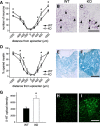Mitogen-activated protein kinase-activated protein kinase 2 (MK2) contributes to secondary damage after spinal cord injury
- PMID: 20943915
- PMCID: PMC6633726
- DOI: 10.1523/JNEUROSCI.2998-10.2010
Mitogen-activated protein kinase-activated protein kinase 2 (MK2) contributes to secondary damage after spinal cord injury
Abstract
The inflammatory response contributes importantly to secondary tissue damage and functional deficits after spinal cord injury (SCI). In this work, we identified mitogen-activated protein kinase (MAPK)-activated protein kinase 2 (MAPKAPK2 or MK2), a downstream substrate of p38 MAPK, as a potential target using microarray analysis of contused spinal cord tissue taken at the peak of the inflammatory response. There was increased expression and phosphorylation of MK2 after SCI, with phospho-MK2 expressed in microglia/macrophages, neurons and astrocytes. We examined the role of MK2 in spinal cord contusion injury using MK2(-/-) mice. These results show that locomotor recovery was significantly improved in MK2(-/-) mice, compared with wild-type controls. MK2(-/-) mice showed reduced neuron and myelin loss, and increased sparing of serotonergic fibers in the ventral horn caudal to the injury site. We also found differential expression of matrix metalloproteinase-2 and 9 in MK2(-/-) and wild-type mice after SCI. Significant reduction was also seen in the expression of proinflammatory cytokines and protein nitrosylation in the injured spinal cord of MK2(-/-) mice. Our previous work has shown that macrophages lacking MK2 have an anti-inflammatory phenotype. We now show that there is no difference in the number of macrophages in the injured spinal cord between the two mouse strains and little if any difference in their phagocytic capacity, suggesting that macrophages lacking MK2 have a beneficial phenotype. These findings suggest that a lack of MK2 can reduce tissue damage after SCI and improve locomotor recovery. MK2 may therefore be a useful target to treat acute SCI.
Figures





References
-
- Alford KA, Glennie S, Turrell BR, Rawlinson L, Saklatvala J, Dean JL. Heat shock protein 27 functions in inflammatory gene expression and transforming growth factor-beta-activated kinase-1 (TAK1)-mediated signaling. J Biol Chem. 2007;282:6232–6241. - PubMed
-
- Antri M, Orsal D, Barthe JY. Locomotor recovery in the chronic spinal rat: effects of long-term treatment with a 5-HT2 agonist. Eur J Neurosci. 2002;16:467–476. - PubMed
-
- Bao F, Chen Y, Dekaban GA, Weaver LC. Early anti-inflammatory treatment reduces lipid peroxidation and protein nitration after spinal cord injury in rats. J Neurochem. 2004;88:1335–1344. - PubMed
-
- Bartholdi D, Schwab ME. Expression of pro-inflammatory cytokine and chemokine mRNA upon experimental spinal cord injury in mouse: an in situ hybridization study. Eur J Neurosci. 1997;9:1422–1438. - PubMed
Publication types
MeSH terms
Substances
Grants and funding
LinkOut - more resources
Full Text Sources
Medical
Molecular Biology Databases
